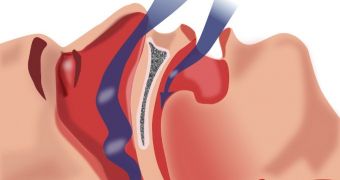Italian researchers propose in a new study that people suffering from obstructive sleep apnea (OSA) can reduce the severity of their symptoms by wearing compression stockings. This represents a low-tech way of taking care of a dangerous condition.
OSA is characterized by the collapse of the superior portions of the airways during sleep. This obstructs the respiratory system for periods of up to 15 seconds, sometimes even more. The patient is unaware of that, but the lack of oxygen to the brain can have severe side-effects.
In more extreme cases, some people even wake up at night feeling like they are suffocating. Of OSA patients, those who also suffer from chronic venous insufficiency (CVI) can reduce their symptoms by wearing compression stockings.
This approach produces no discernible effects for OSA sufferers that do not have CVI, a team of French scientists explains. The group adds that CVI most affects vein in the feet, and is a disease characterized by veins' inability to pump oxygen-depleted blood back to the heart.
“We found that in patients with chronic venous insufficiency, compression stockings reduced daytime fluid accumulation in the legs, which in turn reduced the amount of fluid flowing into the neck at night, thereby reducing the number of apneas […] by more than a third,” Stefania Redolfi, MD, says.
The expert, who holds an appointment at the University of Brescia, in Italy, was the leader of the study. Details of the work appear in the American Thoracic Society's (ATS) American Journal of Respiratory and Critical Care Medicine, e! Science News reports.
“We hypothesized that the fluid accumulation that occurs in the legs of people with chronic venous insufficiency would be reduced by wearing compression stockings, and that the reduction in the fluid would also reduce the shift of that fluid to the neck during the night,” Dr. Redolfi explains.
“There is strong evidence linking that rostral shift of fluid overnight to apnea. If we could reduce that, we would expect that apneic events would likewise be reduced,” the expert goes on to say.
At this time, the only things doctors can do to alleviate OSA symptoms is use a continuous positive airway pressure (CPAP) machines, which involves covering the patient's face with a mask at night.
However, many people prefer not to use it, exposing themselves to unwanted consequences. At the same time, many sufferers live without having their condition diagnosed by a professional doctor.
This is largely caused by the fact that people suspected of suffering from OSA need to be committed to a sleep laboratory for at least a night, and sleep while hooked to special medical devices. This is the only way to properly test sleep apnea.

 14 DAY TRIAL //
14 DAY TRIAL //